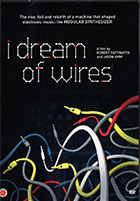
I Dream of Wires 2014
Distributed by First Run Features, 630 Ninth Avenue, Suite 1213, New York, NY 10036; 212-243-0600
Produced by Robert Fattinatto and Jason Amm
Directed by Robert Fattinatto and Jason Amm
DVD, color, 96 min.
High School - General Adult
Electronic Music, Modular Synthesizers, Rock Music, Acid House Music, Experimental Music
Date Entered: 09/15/2015
Reviewed by Vincent J. Novara, Curator, Special Collections in Performing Arts, University of MarylandAs it goes with technology, modular synthesizers had their time and then began the quick fade into obsolescence, replaced by smaller, faster, and easier-to-use instruments. I Dream of Wires does tell that story, but more importantly that of the modular’s resurgence and renewed purpose in contemporary pop music, as well as with keyboard gear enthusiasts. The filmmakers, Robert Fattinatto and Jason Amm, actually best state their case towards the end of the film: “Almost half a century after it was first developed, the modular synthesizer has found a place in our cultural landscape. But for it to finally receive the mainstream recognition that many feel it deserves, surely the modular synthesizer will need to get out of the studio and take its place on the stage where the public can feast their eyes on that mass of knobs, switches, and wires and register recognition, rather than confusion.” The history of the instrument is presented chronologically, starting, perhaps a bit heavy-handedly with the earliest accounts of electricity, then on to the pioneering electronic instruments, through to the electronic music studios at academic institutions in the United States. The footage of nascent electronic music offers fascinating insight into the first experimental instruments and technology that came before, informing viewers why the modular synthesizer was created almost out of sheer necessity. Logically, Robert Moog’s and Don Buchla’s separate innovations with these machines are fully examined, accompanied by the story of the ARP, another early modular. Indeed, thanks to the piano-style keyboard utilized by the Moog and ARP products, and their own efforts to create more compact and mobile gear, a story akin to the recent smartphone wars unfolds, leaving the Buchla machines more in obscurity and, along with the larger modular synths, relegated to academia. The chapter on the development of sequencers is also effective in demonstrating how they function, but also the ongoing role they have in electronic music. In their subsequent explanation of how and why the modular declines, Fattinatto and Amm concurrently provide a concise overview of the rise of the digital synthesizer in the late 1970s and into the 1980s, particularly the once wildly popular Yamaha DX-7.
I Dream of Wires is constructed of historic film footage and still photography of relevant places and many instruments coupled with straightforward narration, albeit a bit stiffly delivered. Interspersed are interviews with many notable figures in electronic music, popular music, and academic or experimental composers. All interviewed express considerable passion for the modular in the present tense, or sincere affection for the role it once had in their earlier creative output. Especially informative are interviews with composers Morton Subotnick, Herb Deutsch, Ramon Sender, and with rock musicians Vince Clarke (Depeche Mode, Erasure), Trent Reznor (Nine Inch Nails), and solo artist Gary Numan. Some of the charm of the instrument is its “other-worldly sounds and striking appearance,” but from listening to those interviewed here half of the fun is the considerable challenge presented by the modular in generating new sounds and arranging them into music.
With original music by the filmmaker Jason Amm (using his Solvent moniker), the film’s content is presented in a constant state of aural context. Solvent’s music demonstrates the relevance the modular can still have in contemporary music, and complements the earlier samples found in the historic film footage. The generous Extra Features include three music videos by Solvent that provide evidence strongly supporting the filmmaker’s thesis for the modular’s role in the current “cultural landscape.” To further this gospel, the documentary proper offers a chapter on the current manufacturers and inventors of new modular synthesizers, which not only reveals the entrepreneurs’ ingenuity, but their own fanaticism for this class of instrument.
The film suffers from one glaring omission, and that is the story jumping from the early 1980s to the 2010s, entirely overlooking the 1990s. Perhaps the Acid House genre can be credited as the greatest champion of the modular in bringing the instrument to a periphery of the mainstream (with a niche market for ultra-enthusiasts); but this overlooks the role that Indie Rock had throughout the 1990s and into the 2000s in keeping the sounds of analog and modular synths in the sonic consciousness of the musically aware. Indeed, at least the bands Stereolab, Tortoise, The High Llamas, and Komeda were due some mention in this film. Furthermore, the more modular-literate might find some aspects of the history presented by Amm and Fattinatto debatable, but to their credit they tend to default on the side of fairness, avoiding any bold pronouncements on who or what came first in the synthesizer narrative.
As work of documentary filmmaking, I Dream of Wires is certainly charming and informative, and viewers will likely be won over to the sounds and sights of the modular synthesizer. But its service to the musicological canon is equal to its entertainment value. Scholars of popular music seeking to broaden knowledge of the instrument and much of the resultant music should spend time with this movie and the expansive bonus content. The “Synth 101 for Beginners” extra feature is especially helpful to filling in any gaps that might still exist beyond the documentary alone. I Dream of Wires will prove useful in the long-term for academic music libraries, but will also earn its shelf space in a public library.